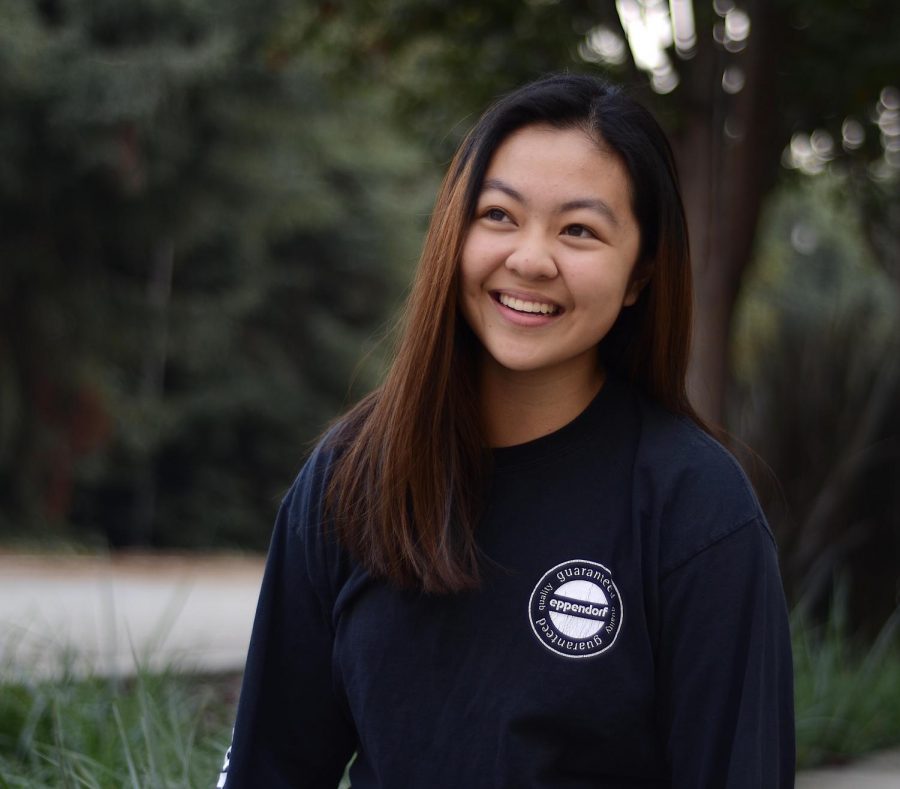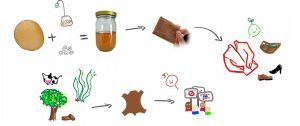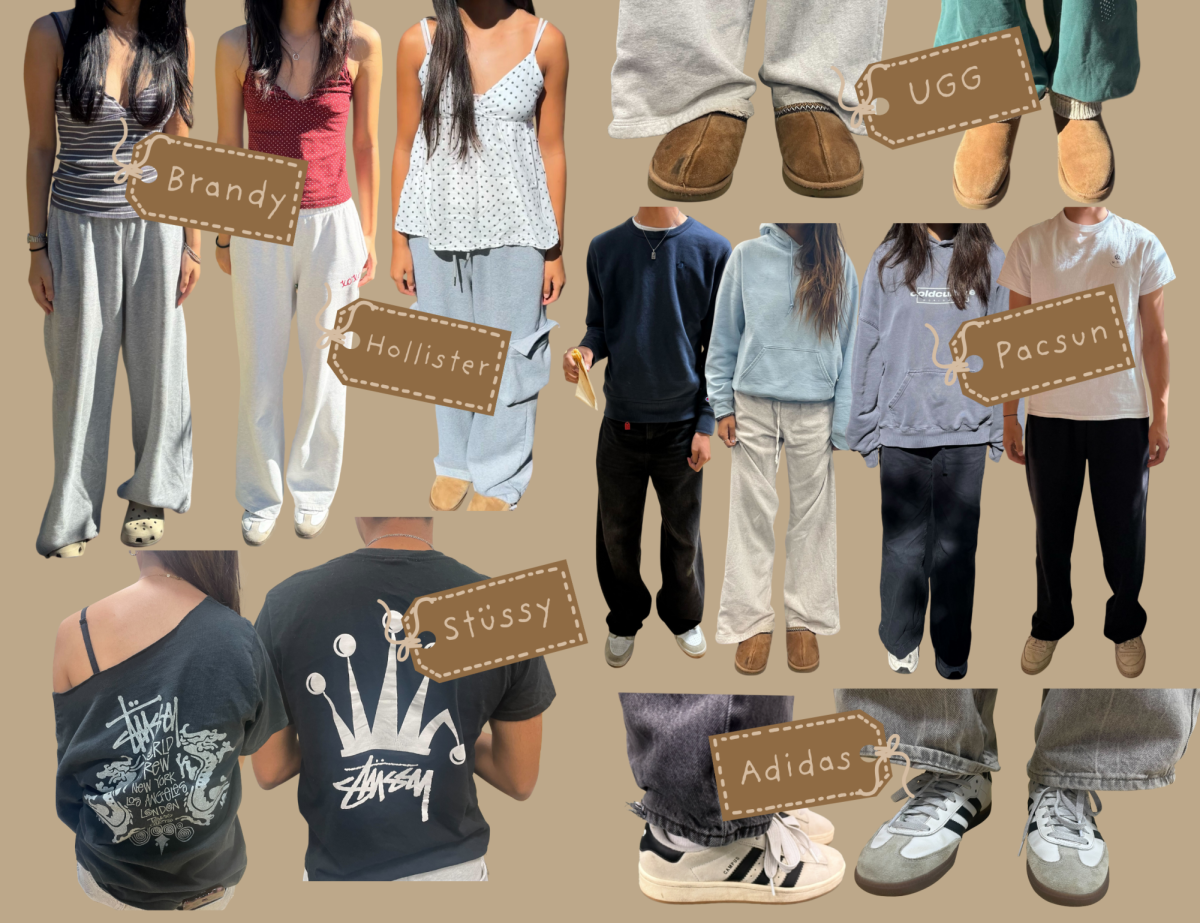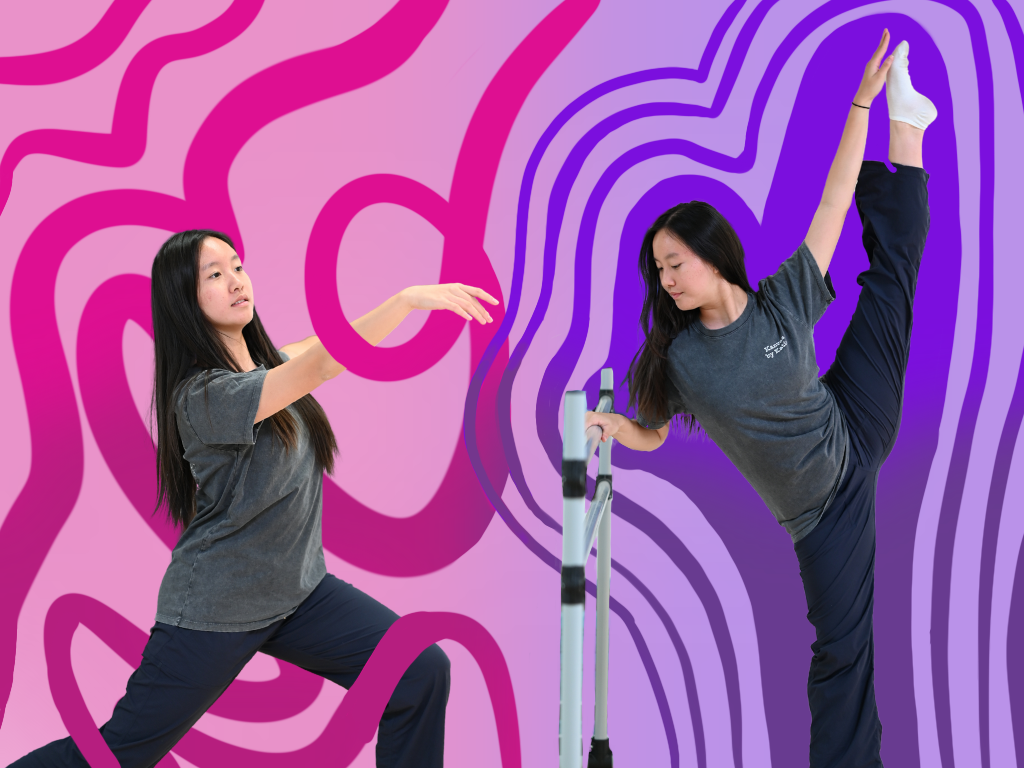Sense or Style?
Emily Chen
Looking back, Kaidi Dai (11) sports a navy blue long sleeve shirt with “it’s what’s inside that counts” embroidered on the back. During her free time, Kaidi enjoys thrifting, and several of her favorite pieces are thrifted.
December 1, 2018
On the hunt for sustainable and eco-friendly clothing? Well, look no further.
Sustainable clothing includes all fabrics created from eco-friendly resources, such as recycled and reused materials or organically grown cotton. Not only does this improved process of producing clothes provide better labor ethics, but it also reduces the landfills and decreased the amount of chemicals released into the air.
Last year, Harker’s Green Team initiated a program based on the principles of sustainable clothing — the Clothing Drive. Inspiring people to approach shopping with a more unique yet unconventional method, the Green Team succeeded in facilitating a place where students and faculty could trade clothes with one another and put their unworn clothing to use.
“We wanted to encourage this practice among the community of not just giving away clothes, but trading it,” Green Team member Alex Shing (11) said. “[The clothing drive] also encourages people to buy less and offer their clothes to someone else who might enjoy them, instead of simply donating it.”
Similar to the Clothing Drive, thrifting achieves the same goals by recycling clothing. Many people think of thrifting as an affordable way to purchase unique and one-of-a-kind pieces, but thrifting actually impacts the fashion industry in a much larger aspect. By recycling excess clothes and utilizing eco-friendly materials, thrifting benefits the environment in tremendous ways, and online thrifting stores, such as ThredUp and Etsy, are leaders of this industry. Known as one of the biggest thrift stores established, ThredUp sells marked down yet on trend clothing, all while valuing the importance of preserving resources and reusing items.
“I think sustainable clothing brands are super important. I heard somewhere that clothing is the second most polluting industry in the United States — which is insane,” Anu Selvaraj (11) said. “Plus, reusing and recycling clothes are super easy ways to save money, and since the clothes that I thrift are normally cheaper, it’s easy to cut up and alter the clothes to make it my own style. Overall, it seems like it would be a lot better for the environment since I feel like people throw out their clothes super often, and this is a way to get new clothes without being wasteful.”
Over the years, the issue of unethical practices in the fashion industry has become a serious topic, inspiring several companies to branch out and use more eco-friendly materials, some even creating entire clothing lines dedicated to sustainable clothing. The only way to truly voice society’s concerns, though, is through the purchases that each individual makes.
“A lot of people think that voting or advocacy are the only ways to be heard, but really where we place our money is one of the biggest ways that we can do that,” Mahika Halepete (11) said. “This clothing industry based on fast fashion is not only wasting materials, but it’s also using sweatshops, child labor, trafficking and all these terrible labor sources. Individuals choose to buy sustainable clothing because they care about the environment and human beings, and once we start thinking about this more and advocating for the environment and human rights, corporations will respond.”
Recently, companies worldwide are accommodating to customer concerns, switching over to more eco-friendly materials and methods. As one of the most well known sustainable clothing brands, Everlane offers affordable prices and ethically-made clothing, associating themselves with the terms “Modern Basics” and “Radical Transparency.” Ranging from shoes to accessories to basics that could be dressed up or down, Everlane provides timeless pieces made out of long-lasting materials for both men and women. According to their website, Everlane takes an ethical approach when choosing factories to partner with, using only environmentally-friendly elements in their clothing. In addition, Everlane has recently added ReNew puffer jackets and parkas to their collection, all of which are made out recycled bottles, using fifteen to sixty bottles per piece.
Aside from Everlane, activewear brands also support the sustainable clothing movement, including Patagonia, PACT and Alternative Apparel. As one of the earliest brands to advocate environmental ethics in the activewear fashion industry, Patagonia has adopted the use of organic cotton and recycled materials. By expanding their partnership with Fair Trade Certified factories, Patagonia has also put more emphasis on the importance of labor ethics. Similarly, PACT has also established an eco-friendly process, growing and harvesting organic cotton in clean and responsible ways. Alternative Apparel focuses on ensuring the rights of all their workers and providing safe working spaces.
“Sustainable clothing brands are more ethical than fast fashion stores, which use child labor and believe in the whole ‘profit is greater than ethics’ model,” Naviya Kapadia (11) said. “I personally feel bad that there’s this whole network of exploitative labor that we, as a capitalist society of extremely privileged people, are just contributing to. Even though I know that by just me not shopping there it’s not going to do anything, but it makes me feel a little better about my choices.”


















![“[Building nerf blasters] became this outlet of creativity for me that hasn't been matched by anything else. The process [of] making a build complete to your desire is such a painstakingly difficult process, but I've had to learn from [the skills needed from] soldering to proper painting. There's so many different options for everything, if you think about it, it exists. The best part is [that] if it doesn't exist, you can build it yourself," Ishaan Parate said.](https://harkeraquila.com/wp-content/uploads/2022/08/DSC_8149-900x604.jpg)




![“When I came into high school, I was ready to be a follower. But DECA was a game changer for me. It helped me overcome my fear of public speaking, and it's played such a major role in who I've become today. To be able to successfully lead a chapter of 150 students, an officer team and be one of the upperclassmen I once really admired is something I'm [really] proud of,” Anvitha Tummala ('21) said.](https://harkeraquila.com/wp-content/uploads/2021/07/Screen-Shot-2021-07-25-at-9.50.05-AM-900x594.png)







![“I think getting up in the morning and having a sense of purpose [is exciting]. I think without a certain amount of drive, life is kind of obsolete and mundane, and I think having that every single day is what makes each day unique and kind of makes life exciting,” Neymika Jain (12) said.](https://harkeraquila.com/wp-content/uploads/2017/06/Screen-Shot-2017-06-03-at-4.54.16-PM.png)








![“My slogan is ‘slow feet, don’t eat, and I’m hungry.’ You need to run fast to get where you are–you aren't going to get those championships if you aren't fast,” Angel Cervantes (12) said. “I want to do well in school on my tests and in track and win championships for my team. I live by that, [and] I can do that anywhere: in the classroom or on the field.”](https://harkeraquila.com/wp-content/uploads/2018/06/DSC5146-900x601.jpg)
![“[Volleyball has] taught me how to fall correctly, and another thing it taught is that you don’t have to be the best at something to be good at it. If you just hit the ball in a smart way, then it still scores points and you’re good at it. You could be a background player and still make a much bigger impact on the team than you would think,” Anya Gert (’20) said.](https://harkeraquila.com/wp-content/uploads/2020/06/AnnaGert_JinTuan_HoHPhotoEdited-600x900.jpeg)

![“I'm not nearly there yet, but [my confidence has] definitely been getting better since I was pretty shy and timid coming into Harker my freshman year. I know that there's a lot of people that are really confident in what they do, and I really admire them. Everyone's so driven and that has really pushed me to kind of try to find my own place in high school and be more confident,” Alyssa Huang (’20) said.](https://harkeraquila.com/wp-content/uploads/2020/06/AlyssaHuang_EmilyChen_HoHPhoto-900x749.jpeg)














